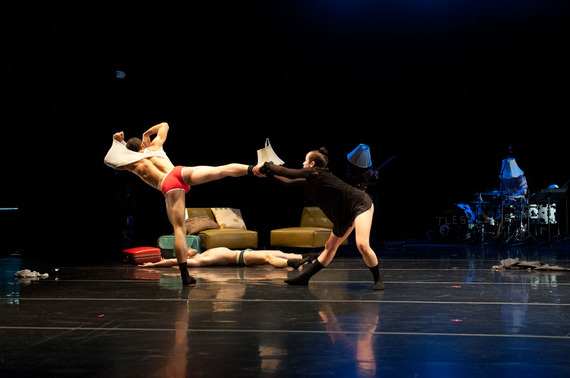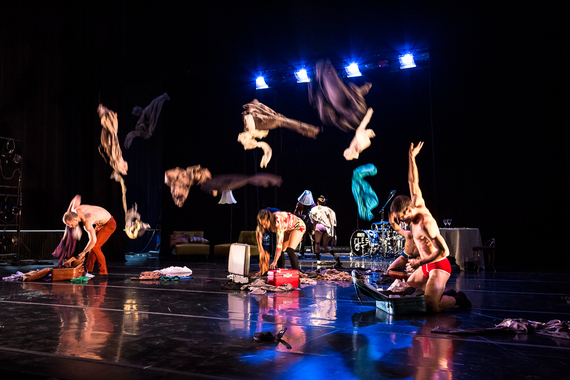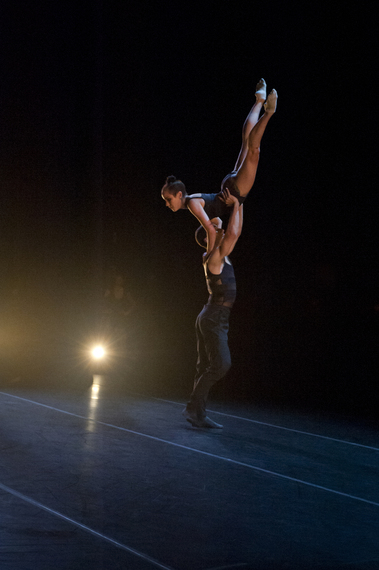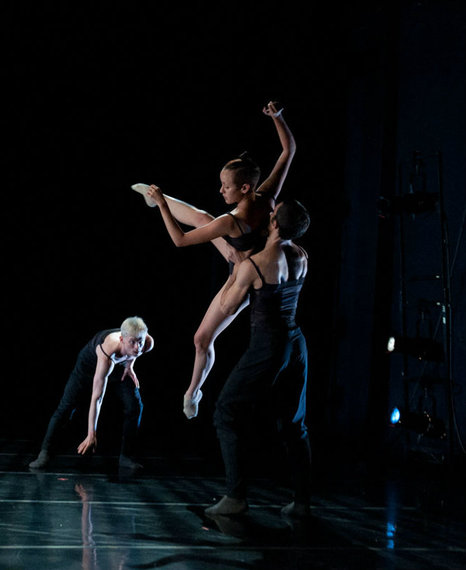Like a René Magritte painting come to life, Robert Dekkers' latest assault on the conventions of theatrical dance piles up one absurd image on another in precise, deliberate fashion, leading us rapidly from a vision of tranquil domesticity into hell and chaos, in concert with Anna Meredith's seductive electronic score - gamely executed by The Living Earth Show, a guitar and percussion duo who wore lampshades over their faces the entire time.
Tassel recalls Dekkers' surreal and somewhat grisly reimagining of Little Red Riding Hood at the West Wave Dance Festival on the same stage at San Francisco's Z Space a year ago, except this time the underlying narrative is not an iconic fairy tale ... Or is it? As the temperature rises, and the five dancers start shedding their somber black, white and grey clothing, stripping down to neon-bright jockey shorts and bras, flinging garments, luggage and furniture around the stage, echoes of the destruction of an ancient temple ring in our ears, along with wailing rock chords from Travis Andrew's electric guitar. The lights, which started flickering halfway through the piece, extinguish on a final tableau anchored by Raychel Diane Weiner who, having been in mysterious communion with the musicians upstage center, slowly revolves to reveal herself bare-breasted, shoulders weighted down with discarded garments, lamp shade over her face. This outlandish goddess stretches one arm out to us hopefully, and we are reminded of the light that burned miraculously for eight days from a single vial of lamp oil, after the Maccabees retook their temple and purified it.
Those who reject the notion of any religious overtone to this piece may instead find thoughts of class warfare and revolution creeping into their brains.
Tassel was introduced by a virtuosic tantrum, courtesy of Andrews and percussionist Andy Meyerson who together make up The Living Earth Show. This musical interlude (or unmusical interlude, as the gentleman behind me grumbled) led us down the garden path with a little bluegrass-y vibe before unleashing the full artillery of Damon Waitkus' North Pacific Garbage Patch. The loudly creaking seats at Z Space and the sound of a backstage door slamming introduced an element of improvisation into this taut, exacting conversation between guitarist and drummer.
The evening opened on a more restrained note, with a reprise of Dekkers' very first piece of choreography dating back to 2010: Flutter, performed to Steve Reich's playful Clapping Music and the wistful, stately Sarabande from Bach's Violin Partita No. 2 in D Minor. Andrews and Meyerson (sans lamp shades) stood downstage left, clapping the syncopated rhythm in a shifting canon, later to be relieved by violinist Kevin Rogers, while Jeremy Bannon-Neches, Christian Squires and Vanessa Thiessen, seated in classic Martha Graham spirals, propelled themselves with sweeping leg motions across the black marley floor as if swimming in an ink-black sea, then skittered across on tip-toe like sea birds at the water's edge. Delicate movements ripple through their torsos to head and fingers, and while the vocabulary remains essentially the same throughout, the contrast between the percussive clapping and the long drawn out breaths of the baroque Sarabande, with a slightly draggy feel to its ¾ metre, evokes a broad range of mood and emotion within this short piece. Such is the intimacy between musicians and dancers that we can no longer tell whether the music is driving the movement or the dancers are spinning the music like spiders spin their webs.
Another revival followed. Sixes and Seven is a Philip Glass-guided exercise in futility, an obsession with trying to count the uncountable: grains of sand on the beach, teaspoons of water in the ocean, stars in the sky, and exactly how much a guy named John loves his girlfriend. Counting is a dancer's way of organizing the world, and the title of the piece appears to be a joke on dancers - who are accustomed to counting steps in 4's and 8's, rarely in 6's or 7's.
The exquisite Tetyana Martyanova debuted in this solo on Thursday night, and Ballet to the People was struck by how different the work feels not just on different dancers (the piece has been performed by men and women) but in different spaces. Scale matters critically in dance: the human versus the scale of the stage and set. At Z Space the stage is smaller, the lighting apparatus less intrusive, and the audience closer than at the Yerba Buena Center for the Arts where Ballet to the People last witnessed its performance by Jessica Collado, who appeared tiny, fragile and vulnerable as she negotiated the enormous space. Martyanova in contrast appeared more serene, and more in command of her environment, as she hopped and glided and shuddered and balanced perilously in various twisted single-leg squats, plucking invisible stars from the sky and sea anemones from intertidal reefs.
Dekkers' other new piece on this program, entitled Yours is Mine and premiered by Atlanta Ballet's Wabi Sabi troupe this past summer, is set to Bodega, an electrifying industrial soundscape by Jonathan Pfeffer, influenced by the duress experienced by war veterans and street kids in the rougher neighborhoods of Philadelphia. Underpinned by a throbbing syncopation, the minimalist, paroxysmal score shares a bloodline with Flutter's Clapping Music. The tentative, gossamery explorations of space in Flutter and Sixes and Seven, however, give way in this piece to a hyper-aggressive vernacular in which space is conquered by diving into it, kicking, leaping, thrusting the chest forward, head butting the air.
Three terrific male dancers (Jeremy Bannon-Neches, Aidan DeYoung and Christian Squires) strut and swagger, staking out their territory on the mean streets, members of the 21st century Jets and Sharks. Every encounter is hostile, threatening and the occasional hint of sexual aggression distills to a matter of power and turf. There are acrobatic lifts and throws, and elements of stylized wrestling and street-fighting, but also flashes of humor (like a swift series of pop-ups into the air with little hip wiggles.) Once Raychel Diane Weiner enters, however, we realize that (program notes be damned) this is one gang, not two at war with each other, and Weiner is not there to taunt them, to add some female sexual tenson or pit them against each other: she is their ringleader, their Capo. The men jointly parade her overhead and toss her heroically from one to another, in the style of George Balanchine's seminal Agon - but like the central female figure in Agon, she calls the shots.
Yours is Mine is a handsome and physically daring piece, but also the least original of the works on this program. Today, adventurous dance companies including DV8 Physical Theatre, the BalletBoyz, Ritmos Family, BirdGang Dance, Kidd Pivot, Cedar Lake Contemporary Ballet and others sculpt elements of ballet, modern, hip hop, capoeira, contact improv, and flamenco into highly athletic metaphors for alienation and violence. Fusion of styles alone doesn't make this kind of work memorable, although it improves the odds. Dekkers' impeccable musicality raises this piece above the competition, but it does not push the envelope the way the other three pieces on this program do.
Photos courtesy Post:Ballet:
1. Jeremy Bannon-Neches, Raychel Diane Weiner and The Living Earth Show (lamp shades on heads) in Robert Dekkers' Tassel (Photo: Natalia Perez)
2. Artists of Post:Ballet in Robert Dekkers' Tassel (Photo: Tricia Cronin)
3. Raychel Diane Weiner and Jeremy Bannon-Neches in Robert Dekkers' Yours is Mine (Photo: Natalia Perez)
4. Christian Squires, Raychel Diane Weiner and Jeremy Bannon-Neches in Robert Dekkers' Yours is Mine (Photo: Natalia Perez)




